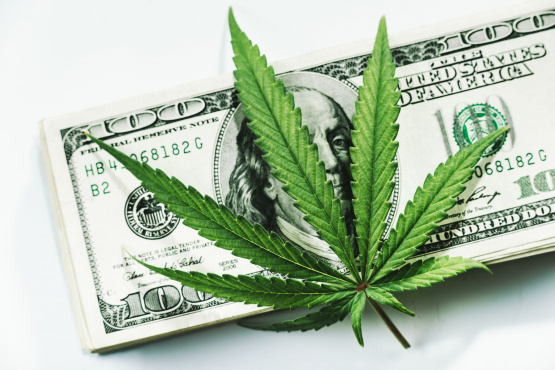Aurora Cannabis: 8 Facts About Its Latest Quarter

Canada's recreational marijuana market is valued at over $5 billion Canadian ($3.71 billion) per year, and that means that leading marijuana stocks are poised to see sales skyrocket following legalization last October.
To make sure it gets its fair share of this opportunity, Aurora Cannabis (NYSE: ACB) has been pouring money into acquisitions and greenhouse expansion. Earlier this week, management reported quarterly financial results showing its strategy is paying off with rapid revenue growth. But the results also show the company has a long way to go before it turns a profit. Here are eight facts you need to know following the company's fiscal third-quarter update.
No. 1: Rapidly rising revenue
The company's net marijuana revenue increased 305% year over year to CA$65.1 million in the quarter, up from CA$54.2 million in its previous quarter. Recreational sales were CA$29.6 million, up 37% from CA$21.6 million in fiscal Q2. Medical marijuana sales improved 12% sequentially to CA$29.1 million, making this the first quarter in which recreational sales accounted for more sales than medical marijuana at the company.
Image source: Getty Images.
No. 2: Higher harvests
Aurora's big investments, including an expansion at its Aurora Sky greenhouse, are paying off in significantly higher marijuana production. In the quarter, it produced 15,590 kilos, up from 7,822 kilos in the prior quarter and 1,206 kilos one year ago. It sold 9,160 kilos, up from 7,000 kilos in the prior quarter, so the company is on track to have plenty of marijuana on hand to drive sales higher this quarter.
No. 3: Stiff competition
Recreational market prices for marijuana are lower than medical marijuana prices, so average prices per gram sold by Aurora Cannabis have been falling as the adult-use market accounts for a larger share of its sales. Last quarter, its average selling price declined 20% year over year to CA$6.40 per gram.
No. 4: Medical marijuana
While recreational sales account for a growing proportion of total revenue, the medical marijuana market remains an important source of sales. In the quarter, Aurora's active patient count grew 5% sequentially to 77,136. For comparison, it was supplying medical marijuana to 45,776 patients one year ago.
Image source: Getty Images.
No. 5: Going international
The global marijuana market is valued at $150 billion, according to the United Nations, so Aurora is actively pursuing opportunities to sell marijuana outside Canada, including in Europe, where management thinks CA$98 billion could be up for grabs. In fiscal Q2, its European medical marijuana revenue surpassed CA$4 million, up from CA$2.9 million in the previous quarter.
It began exporting full-spectrum cannabis extracts to Germany last quarter, and it thinks sales there will increase as more of its facilities are certified as meeting European good manufacturing practices. It has also begun building a facility in Germany following its becoming one of three winning bidders for licenses to cultivate and distribute medical cannabis there. It thinks that facility will begin producing in October 2020.
No. 6: Gross margin
Management believes margin will improve as it achieves scale, but gross margin made little headway last quarter, improving to 55% from 54% in the previous quarter. Last year, its gross margin was 59%.
There's reason to think higher margins are on deck, though. Its cash costs per gram fell 26% sequentially to $1.42 in the quarter, and it's investing to increase production of high-margin extracts, like oils. Extract capacity has crimped margin the past two quarters (extracts only accounted for 18% of net sales last quarter), but capacity is expected to increase from 7,000 kilograms per quarter to 16,000 kilograms per quarter in fiscal Q1, potentially boosting margin next year.
Image source: Getty Images.
No. 7: Peak potential
Aurora Cannabis exited its fiscal second quarter at an annualized marijuana run rate of 120,000 kilograms. And based on planted rooms at its facilities, capacity is now running at a 150,000-kilogram annual pace. Management reiterated its forecast to have 25,000 kilograms of marijuana available for sale exiting June.
Further out, the company's on track to harvest its first production at the Aurora Nordic 1 greenhouse by the end of next quarter, leading to product sales as soon as December 2019. Its go-live date for Aurora Sun is in the middle of 2020. Assuming all goes well, these projects will help it deliver on its 625,000-kilo peak production goal exiting 2020.
No. 8: A path to profits?
In its fiscal second quarter, it lost CA$238 million; in fiscal Q3, it reported a loss of CA$158.4 million. But those figures aren't as bad as they appear.
In fiscal Q2, losses associated with unrealized investments contributed $120 million to its net loss. Last quarter, its increasing stock price correspondingly caused it to revalue CA$460 million in convertible notes it issued in January, forcing it to record a $102 million noncash loss.
Since those unrealized gains and losses can be unpredictable, it could be more instructive to focus on changes in its operating expenses and adjusted EBITDA.
Last quarter, selling, general, and administrative expenses only increased 1% to CA$67.1 million, despite revenue sequentially improving by 20%, and overall, operating expenses increased about 16% sequentially. The company's adjusted EBITDA loss improved by 20% sequentially in the quarter, and as a result, Aurora Cannabis thinks it will produce positive EBITDA this quarter.
More From The Motley Fool
- Beginner's Guide to Investing in Marijuana Stocks
- Marijuana Stocks Are Overhyped: 10 Better Buys for You Now
- Your 2019 Guide to Investing in Marijuana Stocks
Todd Campbell has no
position in any of the stocks mentioned. His clients may have
positions in the companies mentioned.
The Motley Fool has no position in any of the stocks mentioned. The
Motley Fool has a disclosure
policy.